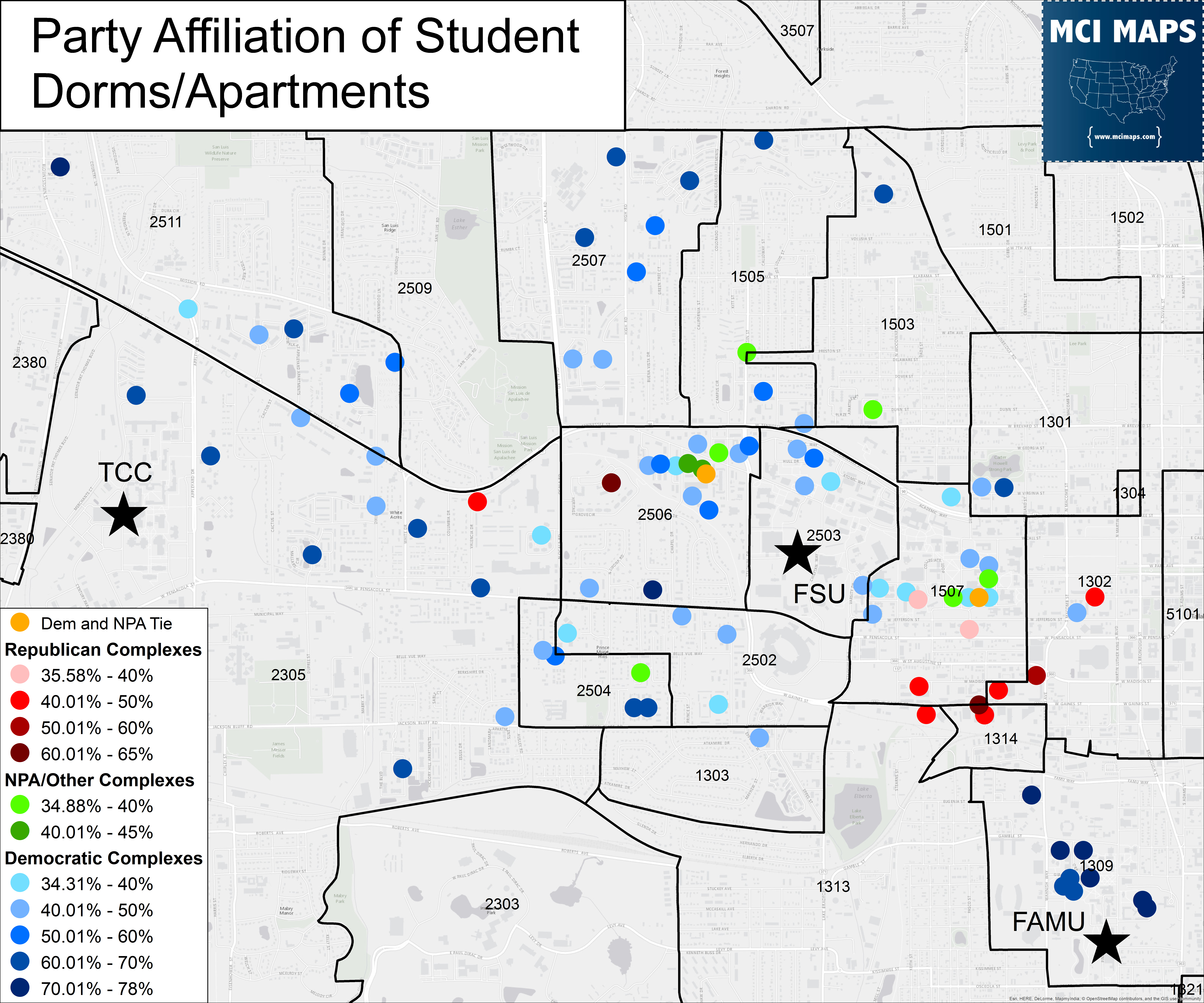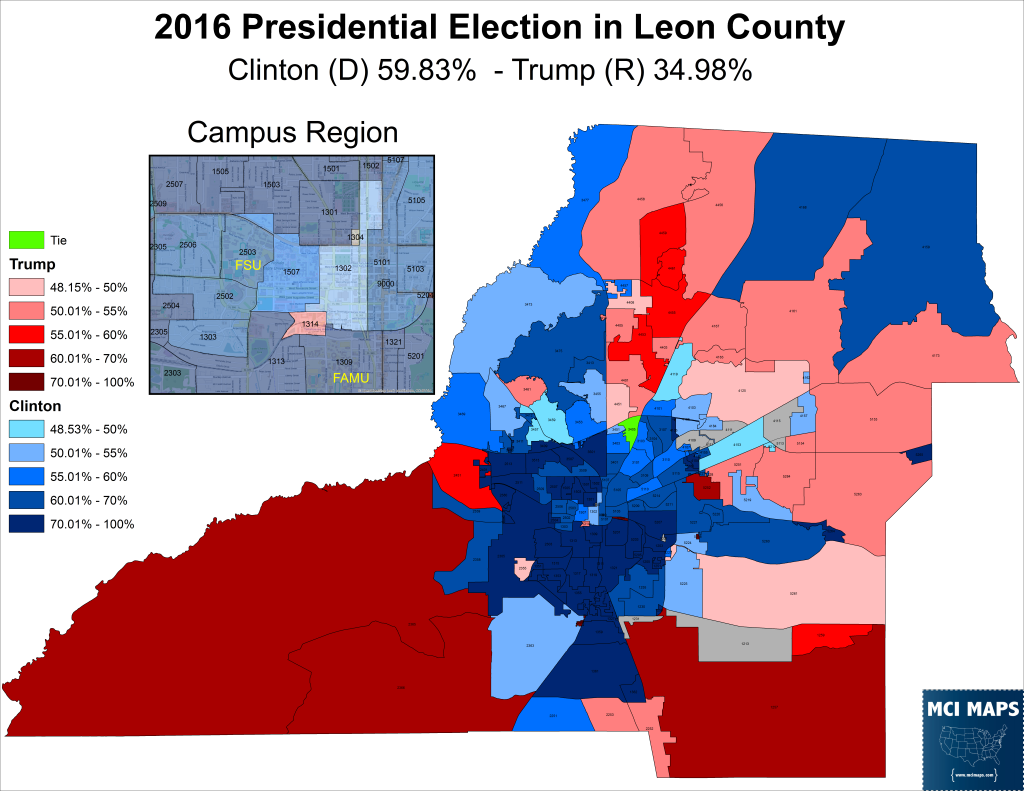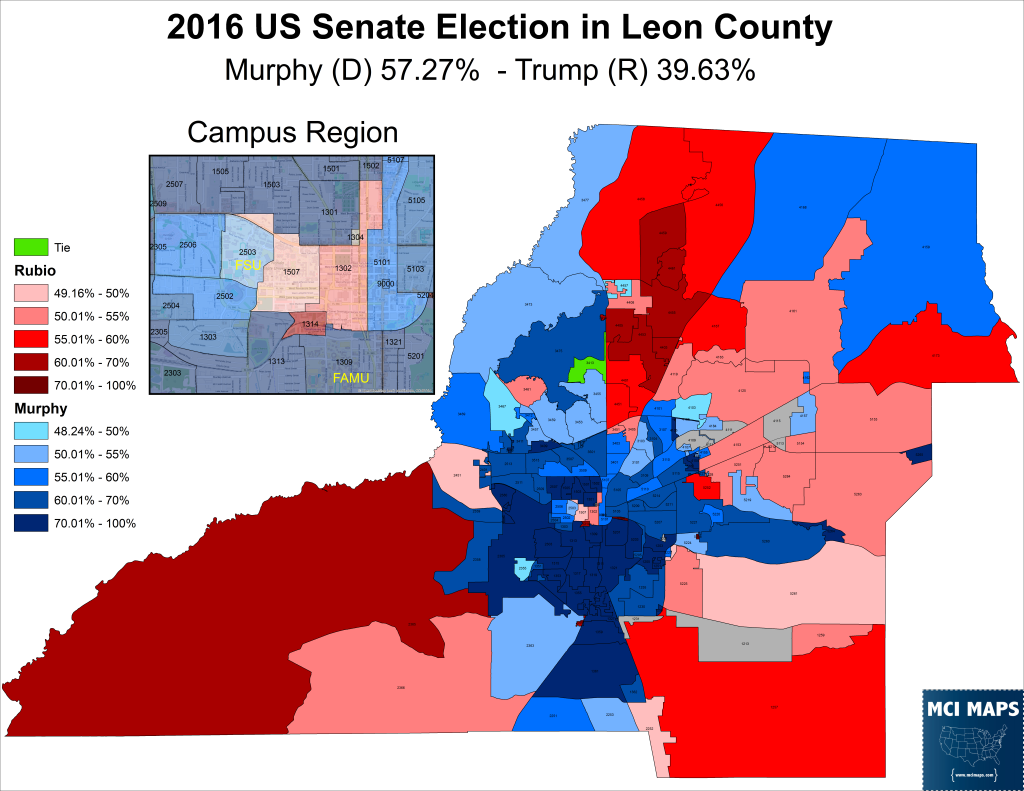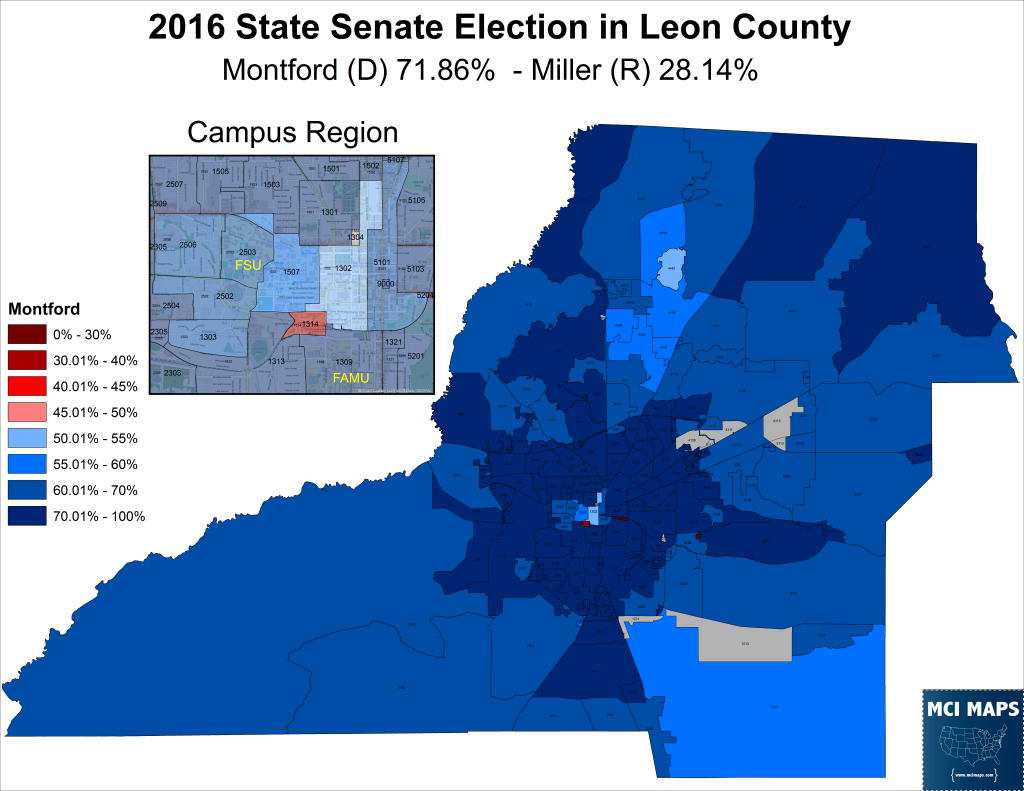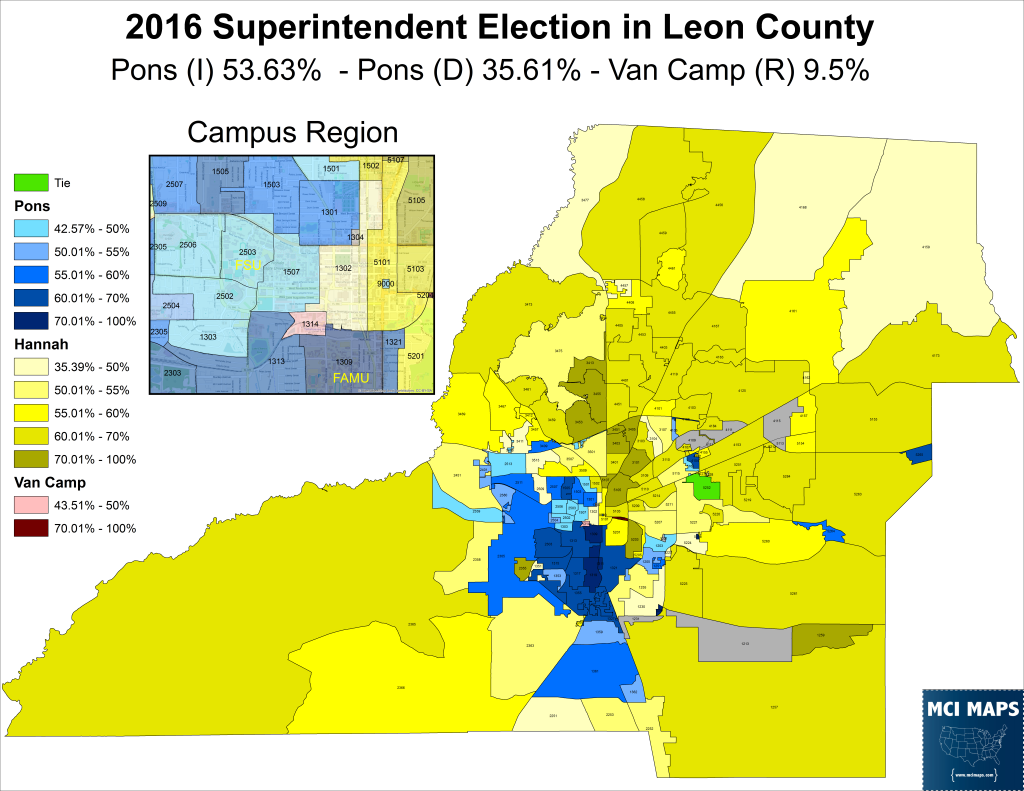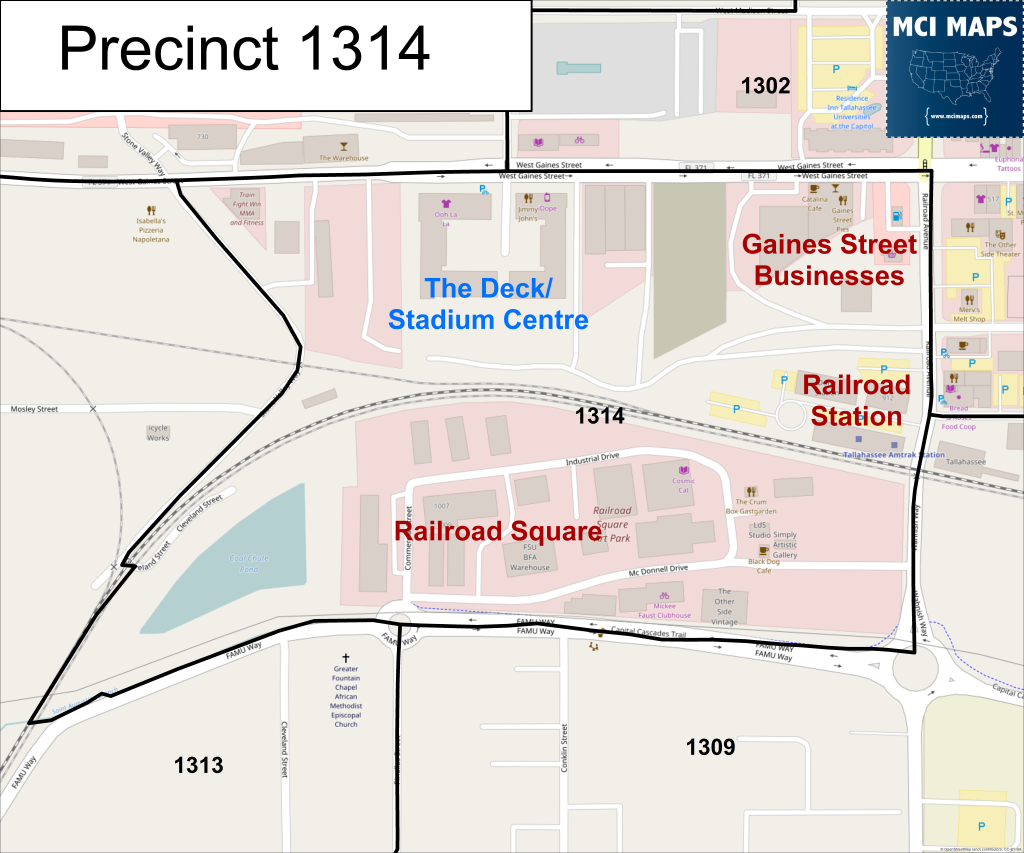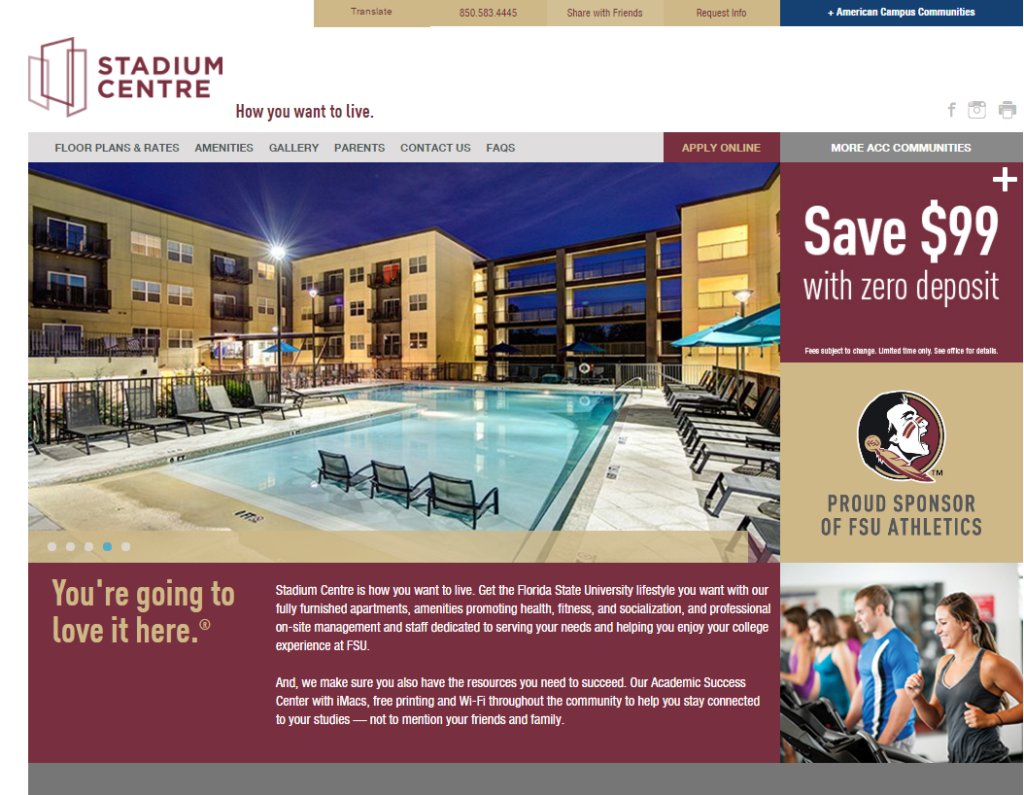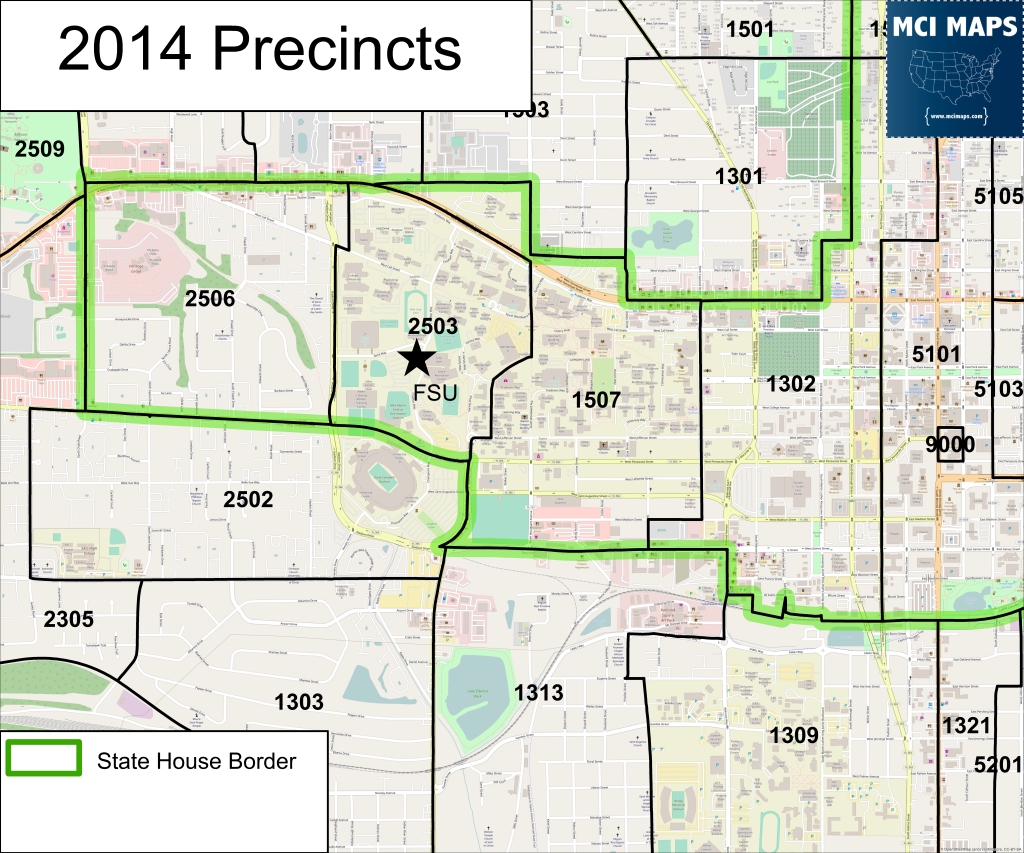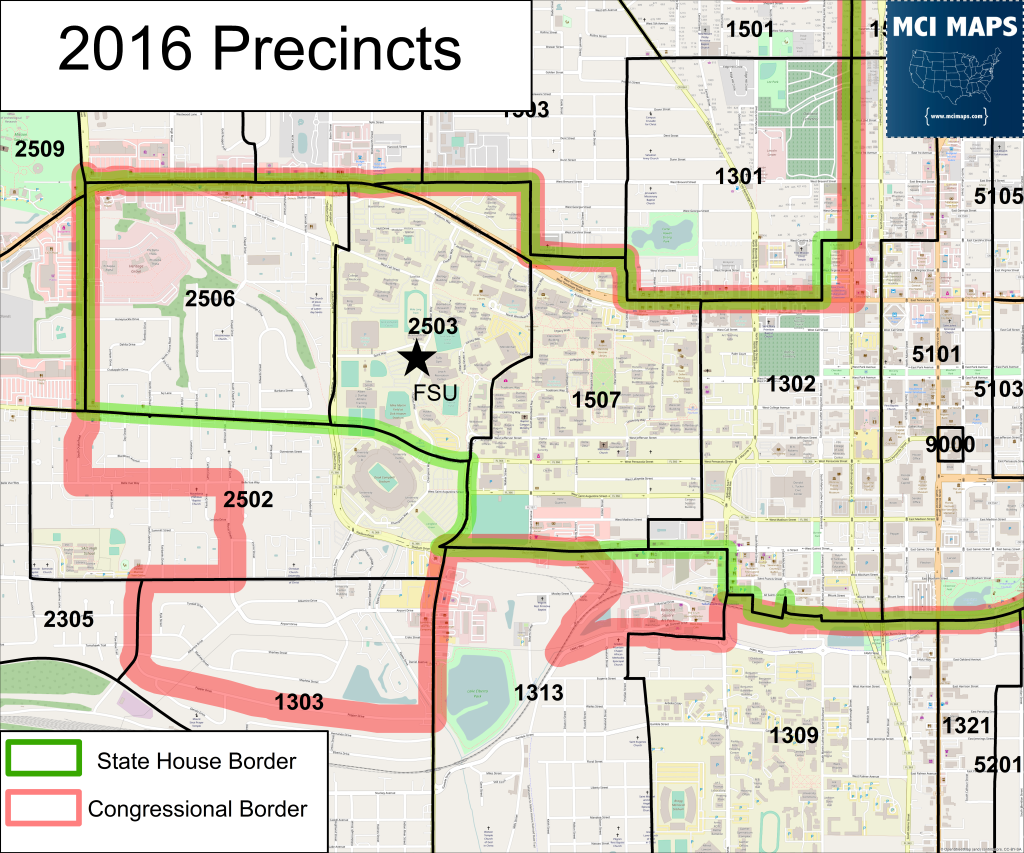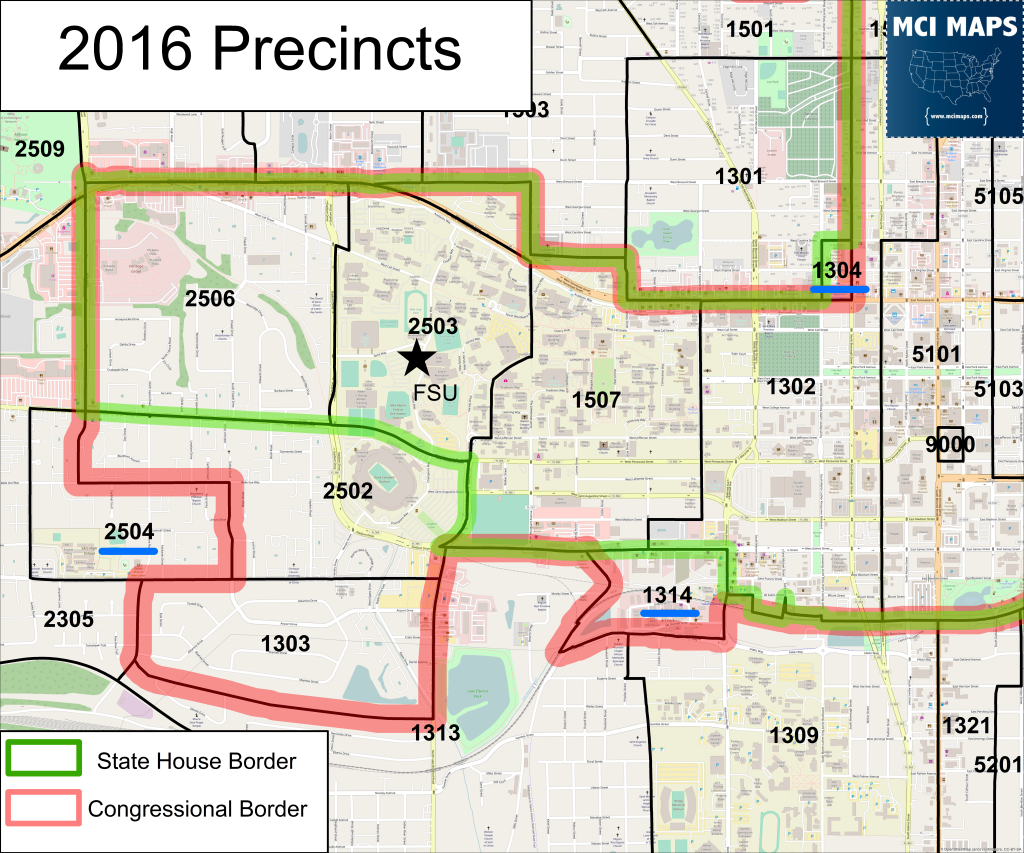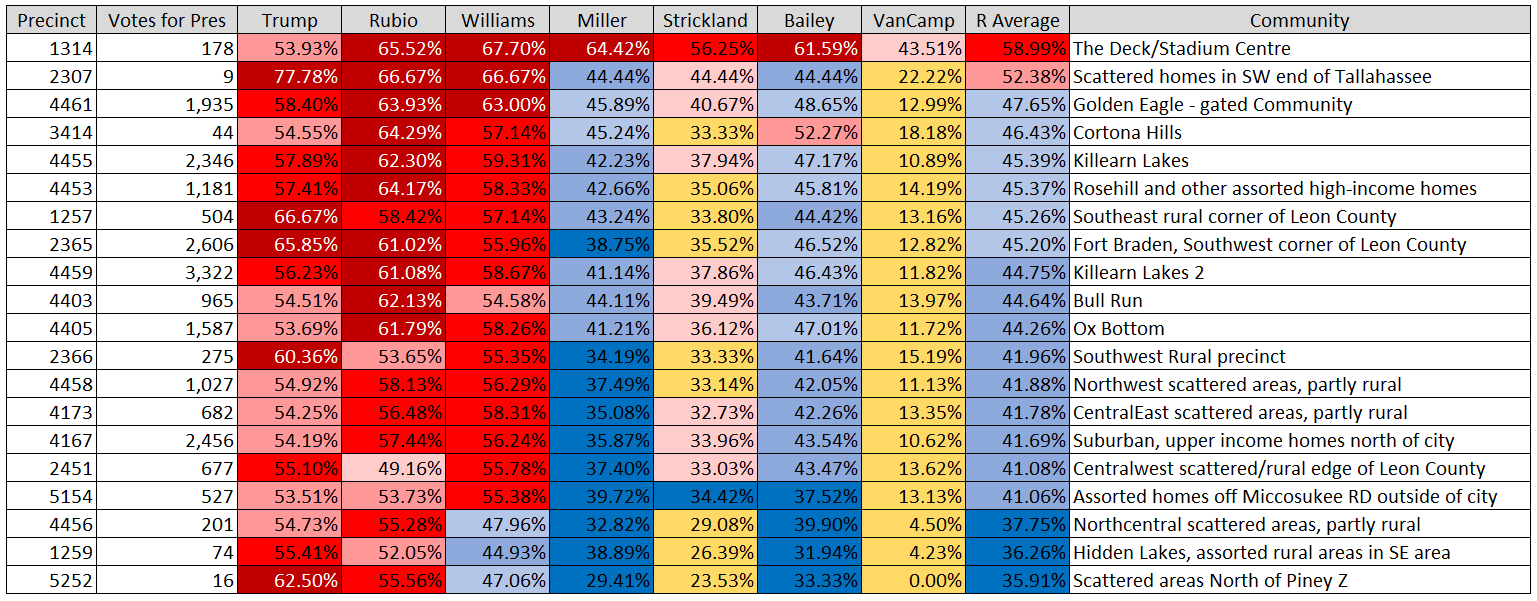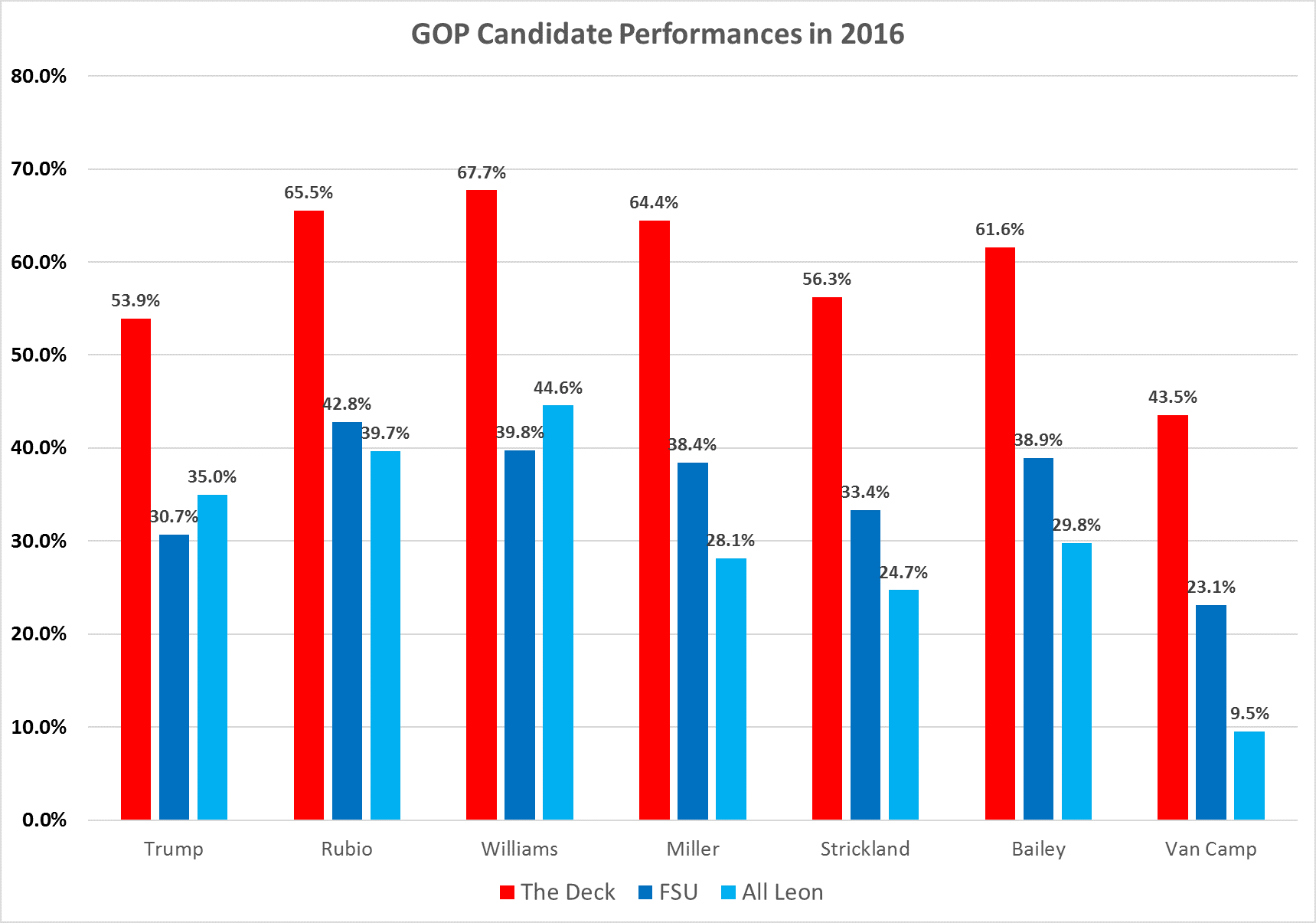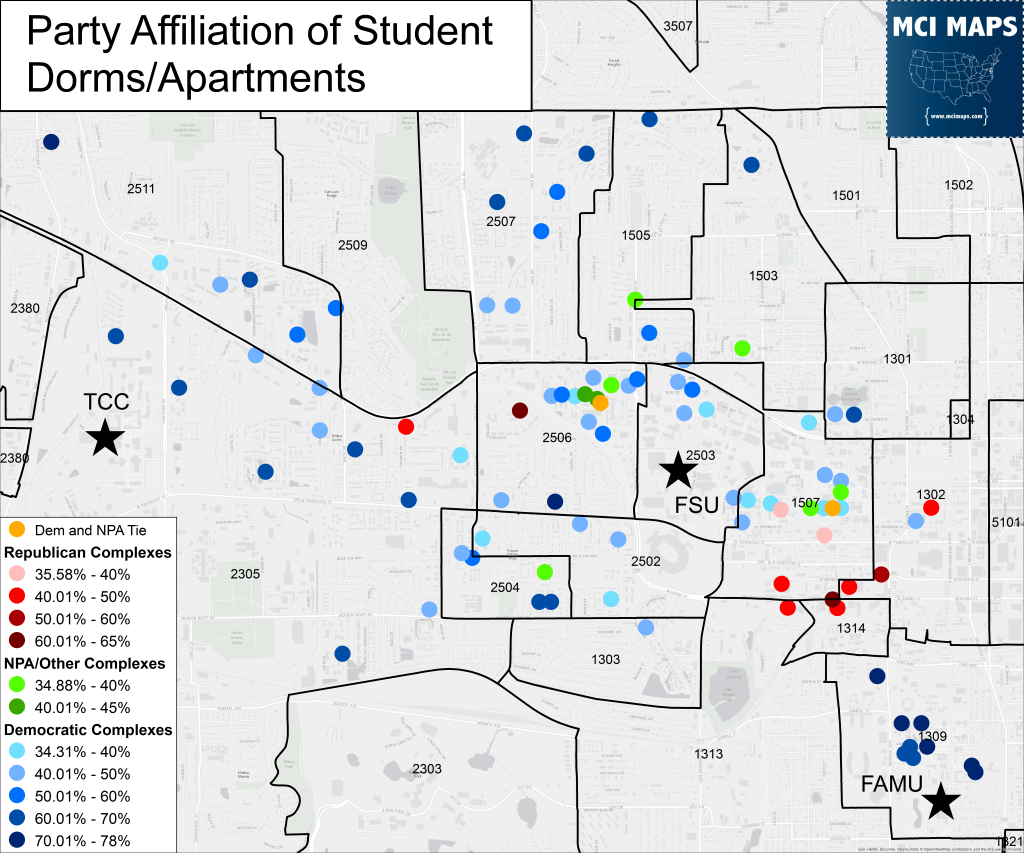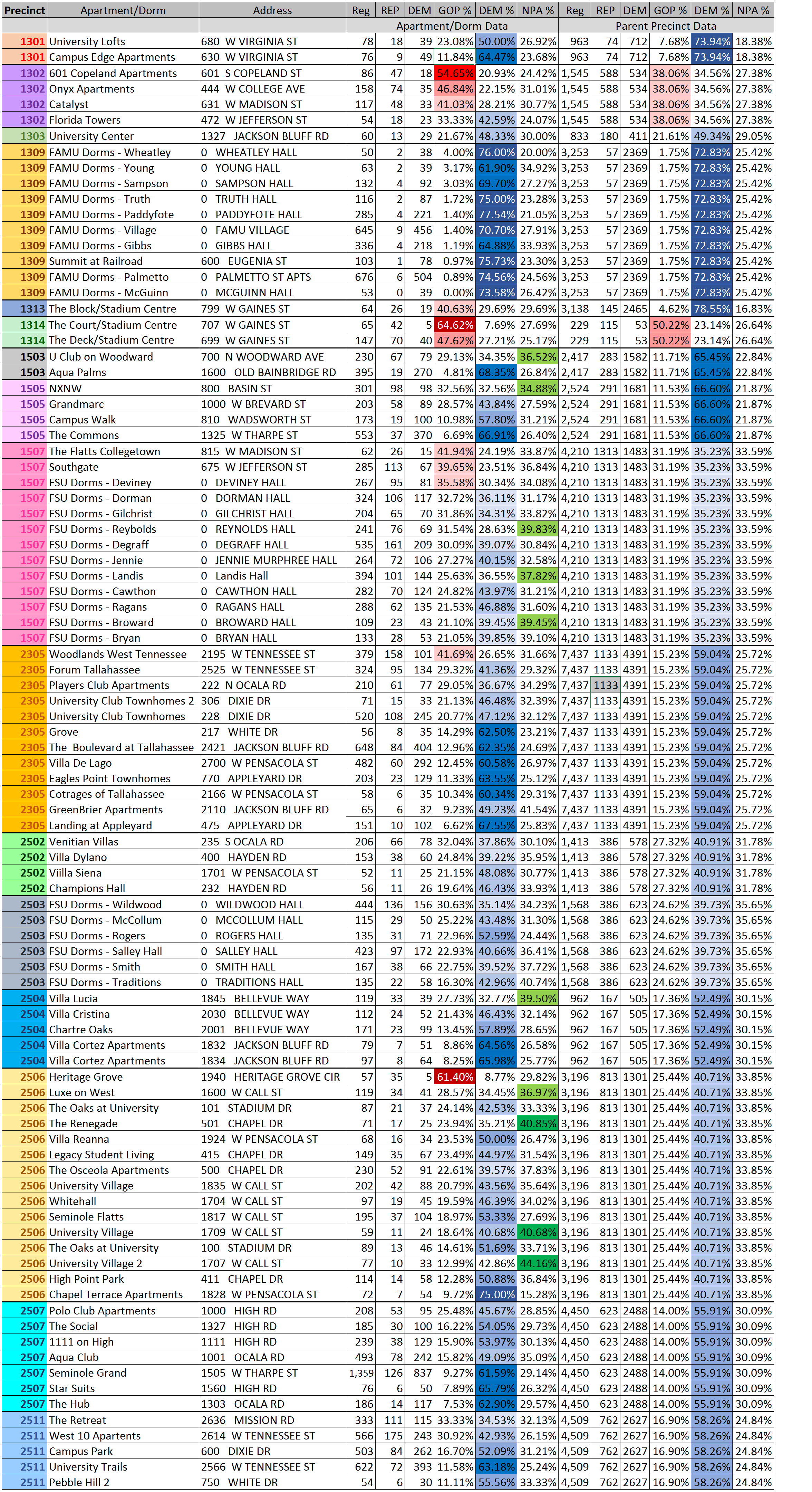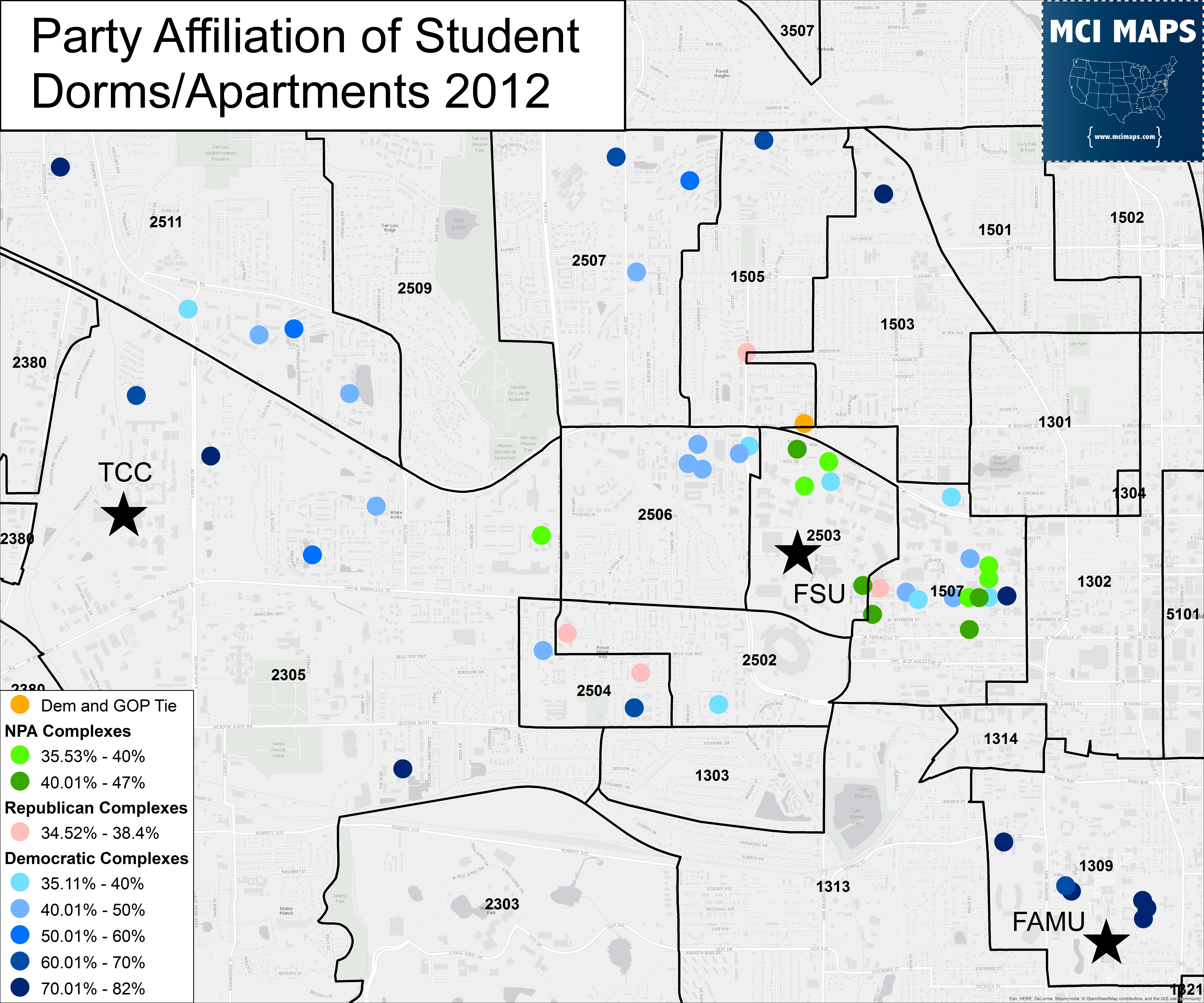Leon County is one of only six Florida counties to vote Democrat for President in every election since 1992. A combination of three campuses (FSU/FAMU/TCC), a notable African-American population, and a large base of state employees, make it a reliable Democratic county. That said, there are plenty of Republican strongholds in the region. Leon’s northern suburbs are typically a reliable Republican base and County District 4, located in the Northeast end of the county, has stayed Republican for decades. Those who follow Leon politics will often name Golden Eagle, a high-end gated community, or Killearn Lakes, a large gathering of high priced suburban houses, as some of the most reliable Republican areas top and down ballot. Fort Braden, a rural community on the southwest end of the county, is often seen as a solidly Republican area.
When digging through the election results from 2016, standard patterns emerged. The northern communities were Trump territory, though some less so than they had been for Romney–a reflection of Trump’s weakness with well-educated voters. Fort Braden went even more for Trump than for past Republicans, reflecting Trump’s strength with working class and rural voters. However, when digging through the precinct map, one red dot in the middle of the college campus region stood out – Precinct 1314.
There, in the middle of a sea of blue, fueled by the African-American populations of Southwide, FAMU, and Frenchtown, and the liberal college students of TCC and FSU, was a red precinct. Precinct 1314 not only went for Trump, it went for Trump by double digits. It wasn’t especially large, only casting 178 votes for the Presidential contest, but it also wasn’t one of the micro precincts made up of just 2 or 3 voters.
Well, one elections only says so much. It was worth investigating the other races. Surely those results where a fluke. I looked at the US Senate race. Again, precinct 1314 voted for the GOP.
In this instance, the precinct was even more in the GOP column, giving Rubio 65.5% of the vote. Two other precincts including students voted for Rubio though, so the results didn’t seem so odd there.
I kept digging. What about State Attorney, a down ballot race not many students were likely to pay attention to?
Nope, precinct 1314 again voted GOP. They gave Republican Pete Williams 67.7% of the vote, more than any other precinct in the county!
As you venture further down ballot, the precinct stands out even more. In the State Senate election, Democratic Incumbent Bill Montford beat back an underfunded Republican, Nancy Miller, by a landslide margin in Leon. Miller had no presence in Leon, and her focus on confederate heritage (yes, seriously) wasn’t exactly a vote winner in Tallahassee. She lost solid Republican areas like Killearn Lakes and Golden Eagle, but still won 1314.
Miller got 64% of the vote in precinct 1314, Golden Eagle was only 45%.
In the multi-candidate Sheriff’s race, the precinct again stuck with the GOP, voting for Republican Charlie Strickland by a solid margin.
Strickland’s 56% was by far his best precinct–the only one he got a majority of the vote in.
In the Tax Collector’s race, the site of another Democratic landslide, 1314 again stuck with the GOP over 16 year incumbent Doris Maloy
Republican John Paul Bailey scored 61% of the vote in 1314, his best showing and one of only two precinct he won.
Then, finally, and truly the icing on the cake, in the Superintendent’s Race, the precinct voted for Republican candidate Forest Van Camp, who only got 9% countywide.
Van Camp scored a 43% plurality win in 1314, miles ahead of any other precinct.
So, precinct 1314 certainly is making a name for itself. I dug in to see what made this precinct so Republican.
Profile of Precinct 1314
I zoomed into the precinct to see what made it up. It sat right in the heart of the Gaines Street/Railroad Avenue district. This was a historical piece of Tallahassee. The precinct included the Railroad Station, built back in the 1800s for the railroad that ran from Jacksonville to Pensacola connecting Tallahassee to major hubs. The precinct included Railroad Square, an arts and business district that is a common sight of fundraisers and parties, which attracts college students and suburbanites. Then I spotted it, an apartment complex, just a few years old, off Gaines Street. The complex, known as Stadium Centre, is made up of two buildings–The Deck and The Court–which accounted for 92% of the registered voters in the precinct.
This complex is the upidomy of upscale student living.
This precinct is upscale student apartments for kids with the families that can afford such high-end living. Single bedroom apartments run for $1,000! A four bedroom is $800 a piece! The complex screams luxurious living. It also makes up virtually every voter in the precinct. The precinct is 50.2% registered Republican–one of the few precincts in the entire county to be over 50% in GOP registration. This isn’t terrible surprising, as higher-income individuals tend to lean Republican. A precinct made up of the children of higher-income, and hence likely GOP, families explains the anomaly of the precinct. In our younger years we tend to reflect the voting behavior of our parents and coming from GOP families means a concentration of GOP students.
Why does Precinct 1314 Exist?
One question has been raised about precinct 1314. Why does it exist? In both geography and population, the precinct is fairly small. In 2014, the precinct did not exist, but was instead part of a larger precinct. When the new precinct map came out for 2016, 1314 was there. So what changed?
The answer is simple: redistricting.
In 2015/2016 the Congressional and State Senate boundaries for Florida were redrawn. Leon was originally only split by state house districts, with the county remaining whole in congressional and state senate lines. However, the new congressional map saw Leon County split in two between Congressional districts 2 and 5.
These were the precincts in and around the FSU campus and the state house boundaries in 2014:
When the new congressional lines were created, they split several precincts around FSU and elsewhere in the county. You can see the congressional line in red.
The Leon SOE has what I consider to be a very sound policy of having no precinct split by a legislative boundary. Due to several precincts being split by the new congressional lines new precinct boundaries had to be created.
Precincts that were split by the congressional lines were divided into two precincts when needed, or borders were shifted between others. In the campus region this resulted in the creation of several new precincts.
The high-end student complexes of 1314 are stuck right between the house and congressional lines, forcing the creation of a new precinct.
Is 1314 the Most GOP Precinct?
Before I delve into this subject, one important disclaimer: When talking precincts, I am excluding four what-we-call “micro-precincts.” These precincts have less than 5 voters, often a result of redistricting. In some only 1 to 3 votes are cast, often from the same family. A few were solid Dem, another was 1 voter that was 100% GOP across-the-board. Technically, this would be the most GOP precinct. However, for the purposes of this analysis we are looking for something with more of a community. I debated leaving out precincts with less than 20 voters, but opted to stick with just removing those largely in one house.
Yes, 1314 is the most GOP precinct in Leon County. It was not the most pro-Trump precinct–actually not even in the top 10. However, its down-ballot performance shows it to be a solid GOP lock in any race no matter the circumstances. Every race where the GOP fielded a candidate, the Republican won. The only time 1314 voted for Democrats was the Clerk of Court and Property Appraiser races, which saw Dems face NPA candidates. Otherwise, it was all GOP. The chart below shows the most GOP precincts in 2016 and how they voted in each partisan D vs. R race.
1314 voted for every GOP candidate and by far had the highest GOP candidate average. Its closest competitor was a small precinct of 9 voters, made up of scattered homes on the southwest end of the city limits. 1314 was the the highest vote share for many GOP candidates yet was much further down on the Trump list. Why could this be? Because of the student population’s anxiety about Trump. Trump’s rhetoric turned him off to many well-educated high income voters. The students of high income parents would easily feel this same anxiety. However, the student population wasn’t exactly focusing intently on other down ballot races, especially more local contests. That is when pure partisan leaning kicked in. Candidates like Malloy or Montford had a respect and familiarity that shielded them in places like Golden Eagle, Killearn Lakes, or Fort Braden. Students do not follow local officials like that, and their partisan nature drives the vote. The well-off student population actually makes it uniquely set up to be more GOP than high end suburbs or rural regions thanks to that lack of local familiarity. How the Deck/Block stacks up compared to the rest of the FSU campus area or county at large is notable.
It is notable that further down ballot the remaining FSU region is more GOP friendly than Leon at-large despite being less Republican with President. This again can be attributed to the lack of familiarity with local candidates. Pure partisan nature drives voting when candidates aren’t known.
Despite it not having the highest Trump share, 1314 is the most GOP precinct in Leon thanks to its down-ballot showing.
The Gaines Street Project and High-End Student Living
High-end complexes for students are on the rise in downtown Tallahassee. In the last four years, several new complexes have risen up, all catering to students from high income families. These complexes sit next to the College Town area off Gaines Street and slightly to the east where the FSU Law School and several frat and sorority houses lie. College Town is part of the “Gaines Street Project”, a massive project by the city of Tallahassee, county, and state that revitalized the region south of FSU’s campus. When I arrived in Tallahassee in 2005, the southern region of campus was a rundown warehouse district. The college party scene restricted itself more to the Tennessee strip, North of the campus. Eventually, a massive undertaking began to transform south of campus. The owners of the warehouse district were bought out. Some buildings were destroyed, some where repurposed. The whole project is summed up well here
A new slew of apartment complexes and businesses were setup to cater to the college population. The construction is still ongoing in some areas, but already the region is full of student shopping, eating, and living. More complexes are in the works as well. Talks of a Publix being built right in the area are also being discussed. No doubt the transformation has been a major success and the city is much better for it.
The complexes that arose in College Town are geared toward high-income students or students from high-income families. They may not say as much, but the high rents mean the bulk of the population will be from families with money. The correlation is that these students are also more likely to lean GOP as a result.
When I was in college, kids with money lived away from campus where the nicer complexes were. However, now the nicer complexes are showing up right by campus, in the heart of the new party scene of College Town. The Stadium Centre apartments are luxury living, full of amenities and right next to restaurants and the College Town clubs. A parking garage is built right into the complex–this is not a place for folks living by FSU because they don’t have a car. Most of these new complexes all sport the high rents that range around $1,000 for a one bedroom or $700-800 per person for a four bedroom. These prices are way outside the norm for Tallahassee where you can easily get a two-story townhouse in the suburbs for $900. No financial aid plan or waiting tables covers this rent plus the bills after.
The results of these new building projects are a geographic concentration of a high income, and hence Republican-leaning students who may before have been more spread out among assorted complexes and rental homes around the area.
The map below shows the dominant party ID of any complex in the campus region with 50 or more registered voters. I eliminated complexes with less than 50% if its voters being under 26 years old.
There are 11 addresses where Republicans lead the registration of the complex, 9 where its over 40%. The 707 West Gaines St building of the Block/Stadium Centre leads with 64% GOP registration. The only complexes in 1314 are both for the Deck/Block, making the precinct solidly Republican. Precinct 1302 has 3 prominent Republican complexes in its borders; all three built/renovated in the last few years. Precinct 1507 hosts two GOP complexes and one GOP-leaning dorm, but holds many other NPA and Democratic dominated student hot spots. The other GOP complexes are buried in other precincts where they are outvoted by the largely Democratic electorate around them. The Deck/Block was in this position in 2014, being outvoted by the rest of precinct 1313.
Here is the list of all these complexes with 50 or more registered voters and their party affiliation. I included the partisan makeup of their parent precinct as well.
All of these complexes with over 40% GOP registration are high-end complexes with expensive rents rivaling the Deck/Block.
In addition to 1314, precinct 1302 houses a good number of GOP complexes, which have actually made GOP registration the dominant choice in the precinct. 1302 was less Dem than other campus precincts, backing Clinton but narrower for other Dems.
The affects of the Gaines Street project and overall downtown rebuilding can really take shape when we look back at the 2012 Voterfile. I mapped out the complexes then using the same criteria and all the heavily GOP-oriented complexes are gone, sticking with those with over 50 registered voters.
All of the GOP-leaning, high-end complexes that have sprung up around Gaines Street and downtown did not exist in 2012. Precinct 1314 under the 2012 data would only include a handful of people. Other than 1314, Precinct 1302 has been the most effected by new GOP complexes. Since 2012 its GOP registration went from 32.8% to 36.7%–a 3.9% increase. In addition, its registered voters have increased by 52%. To compare this with the county as a whole, the registered population has only increased by 8%. Lest you think this is about college students becoming more Republican, it isn’t. Precinct 2503, all FSU dorms, saw its GOP % fall by 1 point while 1507 and 2506 each saw their GOP share rise by 1.5%. Precinct 1507 has also seen its registration increase by 42%, though not on such an uneven partisan level. 1302, however, fell from 61% Obama to 53% Clinton, a drop not seen in any other student precinct that existed in 2012. The chart below shows the 4 precincts dominated by FSU students that didn’t change in boundaries since 2012.
1302, the smallest precinct, and the most susceptible to new residents altering its makeup, saw the a notable shift to the right. 2503, conversely, has become more Democratic as its voter list fell. 2503 is dominated by dorms, some of which have been demolished, resulting in shifting population capacity. Part of this very well could be due to GOP students that might have settled there instead residing in another precinct.
Conclusions
The tale of precinct 1314 and its neighbors shows that how the lines are drawn can effect partisan nature of precincts as well as highlights how new development can alter the partisan nature of an area. Redistricting created a perfect scenario for the Block/Deck to be carved into their own precinct, creating red dot that otherwise would have been swallowed by the heavily blue precinct it came from. Many precincts in Leon have these red or blue spots that we don’t see on the surface. Its easy to think a precinct is uniform and that if its split in two, both sides will be similar in partisan makeup. 1314 shows this is not always the case and that starkly different results can be gotten if the lines move just a little bit. The success of the Gaines Street Project also highlights how changes to a region can alter the partisan makeup of an area. The concentration of high-end complexes, similar to the creation of a high-priced housing development, has led to a concentration of higher-income, and hence lean-Republican individuals. This is not a bad thing, just a fascinating piece of data. What originally started as a look at a small red precinct in the middle of Tallahassee turned into a much larger look at shifting living patterns among students. What this article shows is that the partisan nature of individual precincts can not only be altered by slight shifts in the lines, but also the placement of just a few new apartment complexes.

